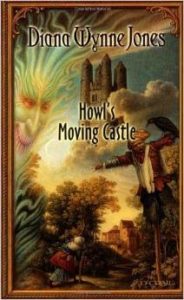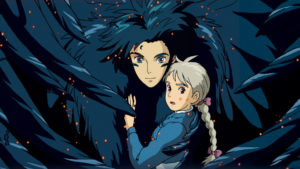As far as film adaptations go, Howl’s Moving Castle isn’t the best. It hardly resembles the book at all…and you know what? I don’t mind. I love them equally.
(Spoilers ahead)
Diane Wynne Jones’ book is delightful. Even though it was written for kids it has some unexpected clever twists and a delightful subtext. As the title suggests the central figures are Howl and his moving castle, but oddly it’s not told from Howl’s point of view. It’s told from Sophie Hatter’s point of view. In the books, Sophie (the eldest of three sisters) is a pessimist who thinks she’s doomed to live a boring, monotonous life — so of course she’s my favorite character. She has the ability to bring objects to life by simply talking to them — an ability that she’s completely unaware of for most of the book — and an incredible inner strength. Sophie gets cursed by a witch that confuses her for one of her sisters. The curse turns Sophie into an old woman. Rather then explain it to her family she runs off, gets a job as Howl’s cleaning lady, and makes a deal with Howl’s fire demon in order to break her curse. By the end of the book Sophie’s curse, and a few others besides, have been broken, the villain is defeated, Howl and Sophie are madly in love, and they live mostly happily ever after.
The film version eliminates one of Sophie’s sisters, Sophie herself has no magical abilities, Howl’s backstory is completely different, and it turned one of her sisters’ suitors into a Marty Stu. There are other changes and omissions but those are the most glaring differences. That aside, it makes up for it with one of the most compelling love stories in anime, the increased strength and resourcefulness of Sophie’s character, and Howl’s abilities as a wizard are much greater. How much greater? Lets say that in the book Howl is Gandalf the lazy grey and in the film he’s sexy Gandalf the White. The English dubbed version also has Christian Bale’s yummy voice as Howl. Seriously yummy! It’s chocolate fudge lava cake with black cherry compote yummy!
Another boon for the film is the GORGEOUS score composed by Joe Hisaishi. (I’m a big fan of Hisaishi’s work. The scores for Howl’s Moving Castle, Princess Mononoke, My Neighbor Totoro, and Robot Carnival are his best!) I know a voice talent and music might seem like cheating since a print book can’t employ those. But it’s one of the advantages that film has.
Any novel adaptation is going to have scenes that either don’t work on film or don’t fit in a script that’s a third of the size of the original work. Sometimes the percentage is much less than that. In my opinion it’s impossible for a film to be scene-by-scene faithful to the original work. The best a screenwriter and director can do is be faithful to the overall message of the story. That above all is why I love this film adaptation. Even though the route it takes to the happy ending is different, the core message — that if you’re strong you can endure any hardship, and love conquers all — is still as strong as ever.




